

Building Brain Literacy in Elementary Students. Practice Makes Perfect For many students, the brain isn't a hot topic of conversation.
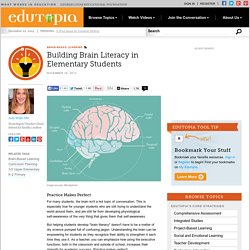
This is especially true for younger students who are still trying to understand the world around them, and are still far from developing physiological self-awareness of the very thing that gives them that self-awareness. But helping students develop "brain literacy" doesn't have to be a matter of dry science pumped full of confusing jargon. Understanding the brain can be empowering for students as they recognize their ability to strengthen it each time they use it. As a teacher, you can emphasize how using the executive functions, both in the classroom and outside of school, increases their strength for academic success.
To reduce anxiety about new "stuff" in the classroom -- whether related to Common Core State Standards, struggles with reading, or something else entirely -- you can find opportunities to emphasize students' ability to literally build the brains they want. A Growing Awareness. Peer-to-Peer Tutoring. Supporting ELLs Through Project Based Learning. Mirrors, Windows, and Sliding Glass Doors. Books are sometimes windows, offering views of worlds that may be real or imagined, familiar or strange.
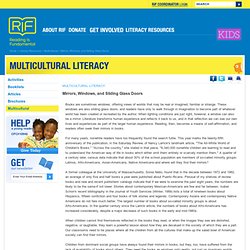
These windows are also sliding glass doors, and readers have only to walk through in imagination to become part of whatever world has been created or recreated by the author. When lighting conditions are just right, however, a window can also be a mirror. Literature transforms human experience and reflects it back to us, and in that reflection we can see our own lives and experiences as part of the larger human experience. Reading, then, becomes a means of self-affirmation, and readers often seek their mirrors in books. For many years, nonwhite readers have too frequently found the search futile. A former colleague at the University of Massachusetts, Sonia Nieto, found that in the decade between 1972 and 1982, an average of only five and half books a year were published about Puerto Ricans.
Consider some of the possibilities. Source: By Rudine Sims Bishop, The Ohio State University. Putting personalization into practice – Student voice and choice (Wk 4) Students do not care how much you know until they know how much you care!
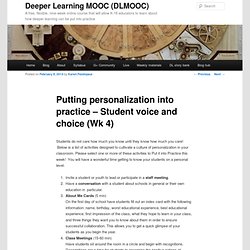
Below is a list of activities designed to cultivate a culture of personalization in your classroom. Please select one or more of these activities to Put it into Practice this week! You will have a wonderful time getting to know your students on a personal level. Internet Catalogue. WP-104. Kids Speak Out on Student Engagement. A while back, I was asked, "What engages students? " Sure, I could respond, sharing anecdotes about what I believed to be engaging, but I thought it would be so much better to lob that question to my own eighth graders. The responses I received from all 220 of them seemed to fall under 10 categories, representing reoccuring themes that appeared again and again. So, from the mouths of babes, here are my students' answers to the question: "What engages students?
" 1. Working with their peers "Middle-school students are growing learners who require and want interaction with other people to fully attain their potential. " "Teens find it most interesting and exciting when there is a little bit of talking involved. 2. Teacher as Learning Documentarian. Looking at student work 'Looking at student work', the focus in the Deeper Learning MOOC this week, has me reminded of a project I have been working on this school year.
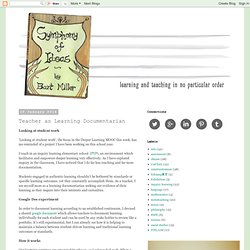
I teach in an inquiry learning elementary school (PYP), an environment which facilitates and empowers deeper learning very effectively. As I have explored inquiry in the classroom, I have noticed that I do far less teaching and far more documentation. DLForEveryStudent_FINAL. Looking Collaboratively at Student Work: An Essential Toolkit. Siderbars:Some Guidelines for Learning from Student Work The Collaborative Assessment Conference The Tuning Protocol: A Process for Reflection on Teacher and Student Work The Primary Language Record & The California Learning Record The 'External Review' of Portfolios and Exhibitions Making the Whole Student Visible: The Descriptive Review of a Child Surfacing the "Opportunity to Demonstrate" Factor Sampling a "Vertical Slice" of Student WorkWhat to Look for in Student Work: Some Standards for 'Authenticity' Examining Student Work: A Constructivist Protocol For More Information Looking closely together at student work can unveil a treasure trove of insights to guide school communities as they reflect on their purpose, assess their progress, and plan strategies for reaching all children better.
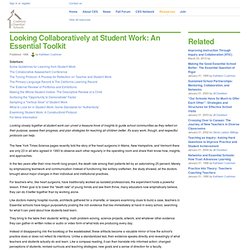
It's scary work, though, and respectful protocols can help. In the two years after their nine-month-long project, the death rate among their patients fell by an astonishing 25 percent. Education Week. UnBoxed: online [ Current Issue ] Deeper learning requires students to think, question, pursue, and create—to take agency and ownership of their learning.
![UnBoxed: online [ Current Issue ]](http://cdn.pearltrees.com/s/pic/th/unboxed-online-current-issue-59722482)
When they do, they acquire deeper understanding and skills, and most important, they become more competent learners in and out of school. They become better prepared to succeed in academics, but also in 21st century careers and in life. We can’t force students to develop agency and drive their own learning. It must come from within. Change the Subject: Making the Case for Project-Based Learning. What should students learn in the 21st century?

At first glance, this question divides into two: what should students know, and what should they be able to do? But there's more at issue than knowledge and skills.